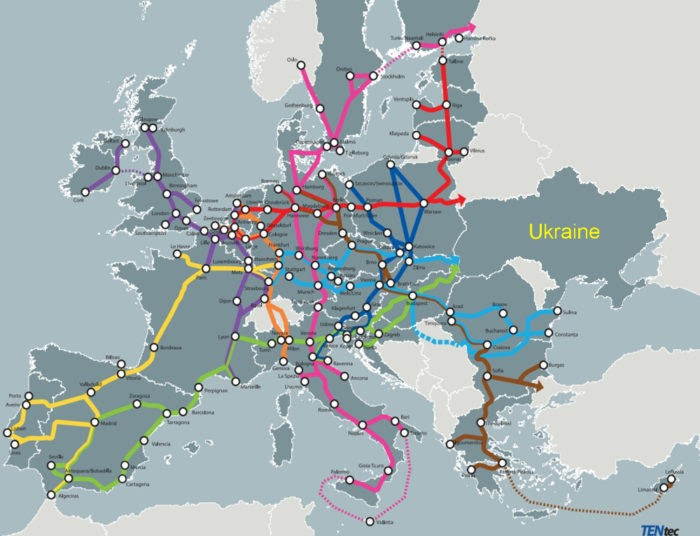
About the strategic role of the TEN-T network
Once again as the people of Ukraine are facing a tragedy, we see how crucial the EU transport network and the role played by different modes of transport are in allowing refugees to leave their country to be safe or enabling the delivery of food, medicines and other commodities needed by those who stayed in Ukraine. War must cease immediately and FEPORT expresses its full support to the Ukrainian people. We hope that peace will prevail again, and that the EU transport network will also play a role in supporting the reconstruction of Ukraine.
Mid-March 2022, FEPORT has been invited to an important hearing organized by the TRAN Committee of the European Parliament regarding the revised TEN-T Regulation. A very timely discussion for the EU, given its environmental and strategic ambitions.
The objective of this hearing was to discuss the revised TEN-T Regulation and clarify why, from the perspective of private companies and terminals operating in European ports, this revision is crucial and must echo other priorities set in the Fit for 55 package and in the sustainable and smart mobility strategy.
FEPORT has always believed in the strategic role of the TEN-T network and in the importance of its completion. Investments in physical infrastructure must go hand in hand with a generalization of the use of digitalization both by public and private stakeholders in all modes of transport, as well as in nodes such as ports.
At this very moment, we see that EU seaports terminals are once again at the forefront of the battle to ensure that EU supplies and imports reach their final destination despite increased cargo checks in ports as a result of the sanctions imposed on Russia. Port activities are strategic for the EU economy in times of peace and even more in times of tensions and war.
In the framework of the ongoing revision of the TEN-T Regulation, it will be essential to elaborate rules that support the multimodal connectivity of European ports and facilitate private investment in superstructure and intermodal solutions.
It will also be crucial that the terminology and provisions of the future TEN-T Regulation remain consistent with other pieces of EU legislation.
But why is the TEN-T Regulation so important for investment and legal certainty?
As already mentioned, infrastructure for the movement of goods and people as well as for data are a prerequisite for Europe’s success in the world.
As private port operators compete and commit themselves to private capital intensive and long-term binding port investments, they expect the EU and national policy makers to create a business-friendly framework with stable rules and foreseeable effects.
Harmonized implementation will also be important and constitutes the backbone of the certainty that private investors need to commit over the long term.
FEPORT members are private entities which invest their own financial resources in superstructure, i.e., equipment, sustainable intermodal solutions, as well as in the training and upskilling of port workers.
Who does what in terms of investments in ports?
Private port companies and terminals invest in superstructure, which can include all types of buildings (warehouses, pavements, offices, etc.), all sorts of improvements in order to operate in an efficient and sustainable manner, and all kinds of IT, fixed, semi-mobile and mobile, equipment. However, infrastructure, which is built, managed and maintained by public port authorities on behalf of Member States or other public entities/cities/administrations, is not in the remit of FEPORT members. It is important that these principles are also safeguarded in the revised TEN-T Regulation.
The revised TEN-T Regulation will also be a powerful instrument to support the greening of the sector and fund the necessary investments to be made in alternative fuels infrastructure. The definition of infrastructure must for instance be consistent with other pieces of legislation, including the Fit for 55 ones.
Another important objective of this revision should be to avoid a waste of public financial resources. This goal can be achieved through the introduction of provisions regarding the maintenance, upgrading and enhancement of existing projects of common interest providing European added value.
FEPORT members are also willing to play a role in proposing environmentally friendly solutions for cargoes leaving ports. They are also willing to get involved in the governance of the core network rail corridors under the condition that administrative burdens are reduced to facilitate the participation of private companies.
Finally, the revised TEN-T Regulation must address the distortive effects of foreign subsidies in the port sector thanks to clear provisions and not only general recommendations.
FEPORT is certainly looking forward to continuing the dialogue with institutional stakeholders to adopt a meaningful and useful revised TEN-T Regulation.

| CONTENTS 28.02.2021 2nd SEArica intergroup meeting on Fit for 55 01.03.2021 US President pursues major container alliances 03.03.2021 TRAN discusses ETD Draft opinion 07.03.2021 Public consultation on Combined Transport Directive 08.03.2022 EU Commission proposes REPowerEU plan 14.03.2022 OECD Commentary to BEPS Pillar 2 15.03.2022 FEPORT participates to the TRAN Hearing on TEN-T 15.03.2022 Information session on the TEN-T Regulation revision 15.03.2022 Council announces a fourth package of sanctions on Russia 15.03.2022 ECOFIN adopts general approach on CBAM 22.03.2022 OSRA Bill passed by U.S. Senate Committee on Commerce, Science, and Transportation 22.03.2022 ENVI Committee discusses EU ET 23.03.2022 Temporary Crisis Framework 24.03.2022 TCG discusses the impacts of Ukrainian war on trade and logistics Members’ News Corner 09.03.2022 HHLA welcomes refugees from Ukraine 18.03.2022 PSA throughput figures for 2021 |





